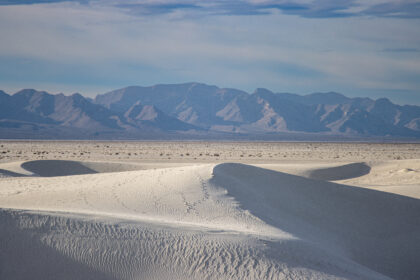
Earlier this month, Simone Biles became the first person to land a Biles II (nee Yurchenko double pike) vault in international competition, securing the right to have it named for her. Based on the Chicago marathon results, we may not be too far from the first competitive marathon run in under two hours. (Eliud Kipchoge has already run the distance in that time, but in an event designed for that purpose where the other runners were providing pacing not competition.) Firsts are exciting, which makes them memorable. But eventually, some firsts do get forgotten. Such is the case when it comes to the first people in the Americas; we don’t know when or how they got here. Timed nicely for Indigenous Peoples’ Day, there are now new results reinforcing a finding that they may have been here earlier than previously inferred.
In 2009, fossilized human footprints were found in the White Sands National Park in New Mexico. Everyone agrees about that; unlike with some possible artifacts, there is no question about who made them or how. Then in 2021, carbon dating results put the footprints at 21,000-23,000 years old. That’s thousands of years earlier than the prevailing consensus dating for human arrival to these continents. So naturally eyebrows and questions were raised.
For dates on this time scale, radiocarbon dating is a reasonable option. However, carbon dating only works on formerly living material. Plants take in radioactive carbon-14 incorporated into carbon dioxide, and animals and microbes get carbon-14 from those plants. While an organism is alive, carbon-14 that radioactively decays is replaced with more carbon-14 from the atmosphere (or plants), resulting in a fairly stable equilibrium. But once the organism dies, there is no new input of carbon-14 while radioactive decay continues, resulting in lower and lower ratios of carbon-14 to carbon-12 over time. Using a carefully adjusted calibration curve, the ratio in a particular sample of material can be associated with a time period in the past ~50,000 years.
While the footprints were made by humans, they don’t themselves contain organic material from those humans. So the 2021 work relied on spiral ditchgrass (Ruppia cirrhosa) seeds found in various rock layers above and below the footprints. The seeds closest to the footprints dated to 21,000-23,000 years ago, and so that age estimate was applied to the footprints as well. There is a complication, however. Spiral ditchgrass is an aquatic plant, and it can obtain carbon from organic molecules in the water as well as from atmospheric carbon dioxide. That can complicating the dating process, since those organic molecules could be from formerly living material that was inside rocks for hundreds or thousands of years while its carbon-14 decayed. That would mean the spiral ditchgrass could have lower amounts of carbon-14 than its strictly CO2-breathing peers, which would put it at an older place on the calibration curve than its actual age.

Bennett et al were aware of this issue when they published in 2021 and mention in their paper several steps they took to rule out that possibility. For example, they found that their dating of material from the various rock layers produced ages that were sequential with the sequence of layers; no dates were out of order. If carbon from the water was throwing off the dates, it is unlikely it would do so in a consistent fashion over a span of thousands of years. That would require that sources from which the water was leeching carbon were from moving window in the past that maintained a roughly fixed interval. They also checked other regional dating results for aquatic and terrestrial plants and found agreement between the two, again suggesting a minimal error from the water.
Nevertheless, the questions persisted because of the significant deviation from other accepted dates. So the new paper by Pigati et al got dates from two other sources, both of which agreed with each other and the first results. The new sources were pollen grains from terrestrial plants, and quartz. If you’re thinking that quartz is not formerly living material, you are correct. Dating the quartz involved a different technique called optically stimulated luminescence. Radioactivity plays a part here, but somewhat the opposite role. As radioactive isotopes decay around the quartz, they release ionizing radiation which results in charged particles accumulating in the quartz. Exposure to light can release the energy from those charges in the form of luminescence. When the quartz is on the surface, sunlight can do the trick, again resulting in an equilibrium. But when the quartz gets buried, there is no more light to trigger the release of energy and so it accumulates. Thus the longer the quartz has been buried, the brighter it will luminesce when it is finally exposed again to light.
I can’t say for sure that this will resolve all questions; there may be other possible sources of error to be accounted for. But the researchers are following the process most likely to yield reliable results, namely collecting additional data and performing additional tests to reduce uncertainty. As we get greater certainly about when people arrived here in the Americas, we may also get more clarity on how they arrived. One of the issues is the timing relative to glaciation events. Certain land routes from Asia were plausible passable at some times and likely unusable at others due to the presence of glaciers. People arriving prior to 23,000 years ago may have had more land-based options available to them than folks arriving more recently.
The pre-history of the first people in the Americas is interesting in its own right. I also wanted to talk about this research because questions about radiocarbon dating in general are common in some communities. I thought it was worth pointing out that the uncertainty in the dating of these footprints, especially the around the spiral ditchgrass dating, does not represent a lack of confidence in radiocarbon dating in general. The possibility of carbon from water sources complicating results is a known issue, and so the data that goes into the calibration curve is chosen to minimize the possibility of such complications. And the curve is calibrated using other independent dating methods. There remain good reasons to think that properly performed radiocarbon dating is reliable even when questions are raised about individual analyses.
Andy has worn many hats in his life. He knows this is a dreadfully clichéd notion, but since it is also literally true he uses it anyway. Among his current metaphorical hats: husband of one wife, father of two teenagers, reader of science fiction and science fact, enthusiast of contemporary symphonic music, and chief science officer. Previous metaphorical hats include: comp bio postdoc, molecular biology grad student, InterVarsity chapter president (that one came with a literal hat), music store clerk, house painter, and mosquito trapper. Among his more unique literal hats: British bobby, captain’s hats (of varying levels of authenticity) of several specific vessels, a deerstalker from 221B Baker St, and a railroad engineer’s cap. His monthly Science in Review is drawn from his weekly Science Corner posts — Wednesdays, 8am (Eastern) on the Emerging Scholars Network Blog. His book Faith across the Multiverse is available from Hendrickson.

Leave a Reply